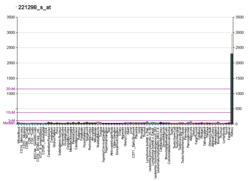SLC22A8
Solute carrier family 22 member 8, or organic anion transporter 3 (OAT3), is a protein that in humans is encoded by the SLC22A8 gene.[5][6][7]
Function
OAT3 is involved in the transport and excretion of organic ions some of which are drugs (e.g., penicillin G (benzylpenicillin), methotrexate (MTX), indomethacin (an NSAID), and ciprofloxacin (a fluoroquinolone antibiotic)) and some of which are pure toxicants.[6] SLC22A8 (OAT3) is indirectly dependent on the inward sodium gradient, which is a driving force for reentry of dicarboxylates into the cytosol. Dicarboxylates, such as alpha-ketoglutarate generated within the cell, or recycled from the extracellular space, are used as exchange substrates to fuel the influx of organic anions against their concentration gradient. The encoded protein is an integral membrane protein and appears to be localized to the basolateral membrane of renal proximal tubule cells.[7]
References
- GRCh38: Ensembl release 89: ENSG00000149452 - Ensembl, May 2017
- GRCm38: Ensembl release 89: ENSMUSG00000063796 - Ensembl, May 2017
- "Human PubMed Reference:". National Center for Biotechnology Information, U.S. National Library of Medicine.
- "Mouse PubMed Reference:". National Center for Biotechnology Information, U.S. National Library of Medicine.
- Race JE, Grassl SM, Williams WJ, Holtzman EJ (1999). "Molecular Cloning and Characterization of Two Novel Human Renal Organic Anion Transporters (hOAT1 and hOAT3)". Biochemical and Biophysical Research Communications. 255 (2): 508–14. doi:10.1006/bbrc.1998.9978. PMID 10049739.
- VanWert AL, Gionfriddo MR, Sweet DH (2009). "Organic anion transporters: Discovery, pharmacology, regulation and roles in pathophysiology". Biopharmaceutics & Drug Disposition. 31 (1): 1–71. doi:10.1002/bdd.693. PMID 19953504.
- EntrezGene 9376
Further reading
- Babu E, Takeda M, Narikawa S, Kobayashi Y, Yamamoto T, Cha SH, Sekine T, Sakthisekaran D, Endou H (2002). "Human Organic Anion Transporters Mediate the Transport of Tetracycline". The Japanese Journal of Pharmacology. 88 (1): 69–76. doi:10.1254/jjp.88.69. PMID 11855680.
- Motohashi H, Sakurai Y, Saito H, Masuda S, Urakami Y, Goto M, Fukatsu A, Ogawa O, Inui K (2002). "Gene expression levels and immunolocalization of organic ion transporters in the human kidney". Journal of the American Society of Nephrology. 13 (4): 866–74. PMID 11912245.
- Nishizato Y, Ieiri I, Suzuki H, Kimura M, Kawabata K, Hirota T, Takane H, Irie S, et al. (2003). "Polymorphisms of OATP-C (SLC21A6) and OAT3 (SLC22A8) genes: Consequences for pravastatin pharmacokinetics". Clinical Pharmacology & Therapeutics. 73 (6): 554–65. doi:10.1016/S0009-9236(03)00060-2. PMID 12811365.
- Bakhiya A, Bahn A, Burckhardt G, Wolff N (2003). "Human Organic Anion Transporter 3 (hOAT3) can Operate as an Exchanger and Mediate Secretory Urate Flux". Cellular Physiology and Biochemistry. 13 (5): 249–56. doi:10.1159/000074539. PMID 14586168.
- Sakurai Y, Motohashi H, Ueo H, Masuda S, Saito H, Okuda M, Mori N, Matsuura M, et al. (2004). "Expression Levels of Renal Organic Anion Transporters (OATs) and Their Correlation with Anionic Drug Excretion in Patients with Renal Diseases". Pharmaceutical Research. 21 (1): 61–7. doi:10.1023/B:PHAM.0000012153.71993.cb. hdl:2433/144752. PMID 14984259.
- Srimaroeng C, Chatsudthipong V, Aslamkhan AG, Pritchard JB (2004). "Transport of the Natural Sweetener Stevioside and Its Aglycone Steviol by Human Organic Anion Transporter (hOAT1; SLC22A6) and hOAT3 (SLC22A8)". Journal of Pharmacology and Experimental Therapeutics. 313 (2): 621–8. doi:10.1124/jpet.104.080366. PMID 15644426.
- Tahara H, Shono M, Kusuhara H, Kinoshita H, Fuse E, Takadate A, Otagiri M, Sugiyama Y (2005). "Molecular Cloning and Functional Analyses of OAT1 and OAT3 from Cynomolgus Monkey Kidney". Pharmaceutical Research. 22 (4): 647–60. doi:10.1007/s11095-005-2503-0. PMID 15846473.
- Erdman AR, Mangravite LM, Urban TJ, Lagpacan LL, Castro RA, de la Cruz M, Chan W, Huang CC, et al. (2005). "The human organic anion transporter 3 (OAT3; SLC22A8): Genetic variation and functional genomics". AJP: Renal Physiology. 290 (4): F905–12. doi:10.1152/ajprenal.00272.2005. PMID 16291576.
- Tahara H, Kusuhara H, Maeda K, Koepsell H, Fuse E, Sugiyama Y (2006). "Inhibition of Oat3-Mediated Renal Uptake As a Mechanism for Drug-Drug Interaction Between Fexofenadine and Probenecid". Drug Metabolism and Disposition. 34 (5): 743–7. doi:10.1124/dmd.105.008375. PMID 16455804.
- Bhatnagar V, Xu G, Hamilton BA, Truong DM, Eraly SA, Wu W, Nigam SK (2006). "Analyses of 5′ regulatory region polymorphisms in human SLC22A6 (OAT1) and SLC22A8 (OAT3)". Journal of Human Genetics. 51 (6): 575–80. doi:10.1007/s10038-006-0398-1. PMID 16648942.
- Kikuchi R, Kusuhara H, Hattori N, Shiota K, Kim I, Gonzalez FJ, Sugiyama Y (2006). "Regulation of the Expression of Human Organic Anion Transporter 3 by Hepatocyte Nuclear Factor 1 /beta and DNA Methylation". Molecular Pharmacology. 70 (3): 887–96. doi:10.1124/mol.106.025494. PMID 16793932.
- Mizuno N, Takahashi T, Iwase Y, Kusuhara H, Niwa T, Sugiyama Y (2007). "Human Organic Anion Transporters 1 (hOAT1/SLC22A6) and 3 (hOAT3/SLC22A8) Transport Edaravone (MCI-186; 3-methyl-1-phenyl-2-pyrazolin-5-one) and Its Sulfate Conjugate". Drug Metabolism and Disposition. 35 (8): 1429–34. doi:10.1124/dmd.106.013912. PMID 17502342.
- Matsumoto S, Yoshida K, Ishiguro N, Maeda T, Tamai I (2007). "Involvement of Rat and Human Organic Anion Transporter 3 in the Renal Tubular Secretion of Topotecan [(S)-9-Dimethylaminomethyl-10-hydroxy-camptothecin hydrochloride]". Journal of Pharmacology and Experimental Therapeutics. 322 (3): 1246–52. doi:10.1124/jpet.107.123323. PMID 17556638.
- Nozaki Y, Kusuhara H, Kondo T, Iwaki M, Shiroyanagi Y, Nakayama H, Horita S, Nakazawa H, et al. (2007). "Species Difference in the Inhibitory Effect of Nonsteroidal Anti-Inflammatory Drugs on the Uptake of Methotrexate by Human Kidney Slices". Journal of Pharmacology and Experimental Therapeutics. 322 (3): 1162–70. doi:10.1124/jpet.107.121491. PMID 17578901.
- Vanwert AL, Bailey RM, Sweet DH (2007). "Organic anion transporter 3 (Oat3/Slc22a8) knockout mice exhibit altered clearance and distribution of penicillin G". AJP: Renal Physiology. 293 (4): F1332–41. doi:10.1152/ajprenal.00319.2007. PMC 2820253. PMID 17686950.
- VanWert AL, Sweet DH (2007). "Impaired Clearance of Methotrexate in Organic Anion Transporter 3 (Slc22a8) Knockout Mice: A Gender Specific Impact of Reduced Folates". Pharmaceutical Research. 25 (2): 453–62. doi:10.1007/s11095-007-9407-0. PMC 2820254. PMID 17660957.
- Windass AS, Lowes S, Wang Y, Brown CD (2007). "The Contribution of Organic Anion Transporters OAT1 and OAT3 to the Renal Uptake of Rosuvastatin". Journal of Pharmacology and Experimental Therapeutics. 322 (3): 1221–7. doi:10.1124/jpet.107.125831. PMID 17585018.




